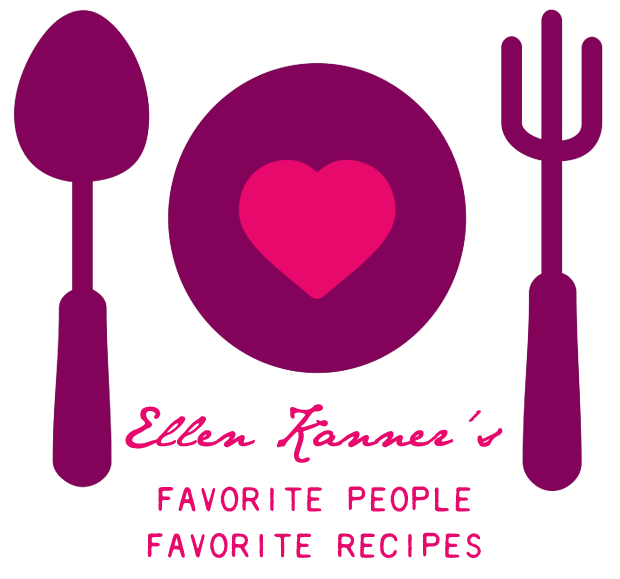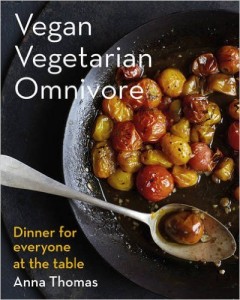My Favorite People, My Favorite Recipes: Anna Thomas
 Welcome to the debut of My Favorite People, My Favorite Recipes, which celebrates just that — people who inspire me in and out of the kitchen, on and off the page. Meet Anna Thomas, who’s been showing the world all the luscious things meatless cuisine can be since her seminal 1970s book The Vegetarian Epicure. She’s racked up some awards since then, including an Academy Award nomination for the screenplay of El Norte and a James Beard Award for her cookbook Love Soup. Not too shabby. And she hasn’t lost her touch. Her new book Vegan Vegetarian Omnivore, her delicious way of bringing everyone to the table, is Anna at her innovative and warm-hearted best.
Welcome to the debut of My Favorite People, My Favorite Recipes, which celebrates just that — people who inspire me in and out of the kitchen, on and off the page. Meet Anna Thomas, who’s been showing the world all the luscious things meatless cuisine can be since her seminal 1970s book The Vegetarian Epicure. She’s racked up some awards since then, including an Academy Award nomination for the screenplay of El Norte and a James Beard Award for her cookbook Love Soup. Not too shabby. And she hasn’t lost her touch. Her new book Vegan Vegetarian Omnivore, her delicious way of bringing everyone to the table, is Anna at her innovative and warm-hearted best.
![]()
Come and eat with me! by Anna Thomas

Anna Thomas © Picture by Ladye Stewart
A few years ago I heard a friend lamenting that she couldn’t invite people over for dinner anymore. Then I began hearing that lament over and over again – in line at the grocery store, out with friends, anywhere. “This one won’t eat that, and another one eats only this…” We seemed to be living in an era of warring food tribes. And people were afraid to invite their friends to the table! It sounded like the end of civilization to me.
Food is important to me. I care about what I put on the table. But there is something more important than what is on the table, and that is – who is at the table? And I want that to be…
Everyone.
I want to invite everyone, all my friends, and their friends, and my relatives (at least on Thanksgiving). Let all the tribes feel welcome and honored at my table. I started to think about how to prepare a meal that would work for everyone. Some cooks I know have resorted to preparing two meals, but that strikes me as way too much work and, even worse, if there are two meals there is inevitably an A meal and a B meal. And who wants to be eating the B meal?
Open arms, open table – that’s the feeling I want.
I thought about how we plan meals. Most of us were raised to think: meat in the middle, and this or that on the side. And yes, we can start there and adapt and be flexible, but then we are immediately taking away, substituting – compromising. We’re doing this backwards, I thought.
We’re doing it backwards! Flip it over. Start with the food everyone eats, and make it work right there, at the greener end of the big curve. Then elaborate and expand, include wider circles of ingredients — as accessories.
Anna Thomas: Start with the food everyone eats, and make it work right there, at the greener end of the big curve. Share on X
It seemed so astoundingly obvious, yet at the same time mind-blowing and new. Just start with the food everyone eats. Who doesn’t eat the watermelon at the picnic? It’s not the vegan watermelon, it’s just the watermelon. Who doesn’t eat the guacamole and chips at the party, the arugula salad, the hummus on the mezze table, the minestrone or the penne arrabiata? Start vegan, is what it comes down to – because we’re all vegan until we eat the cheese or the prosciutto.
 That’s how Vegan Vegetarian Omnivore was born. Start with the food everyone eats. It was a blazingly simple idea — but it took some thinking to apply it in real life, to design flexible meals that would start vegan yet not shut out the omnivores. As I tinkered with recipes and menus I found ideas that worked again and again, and those ideas became templates.
That’s how Vegan Vegetarian Omnivore was born. Start with the food everyone eats. It was a blazingly simple idea — but it took some thinking to apply it in real life, to design flexible meals that would start vegan yet not shut out the omnivores. As I tinkered with recipes and menus I found ideas that worked again and again, and those ideas became templates.
One thing I love to do is to start with a great grain – a risotto or tabbouleh or a formidable, hearty pilaf of farro and black rice – and build a meal around that. My whole grain olive oil flatbread became one of those “anchor” dishes. I made it the first time to serve as an appetizer – rosemary and sea salt sprinkled across the top to give it an herbal punch, and earthy truffle honey as an optional drizzle. But I also served some Mojo Verde alongside. And I slid a panful of blistered cherry tomatoes into a shallow bowl and put that on the counter, too. And some garlicky cannellini spread. I couldn’t seem to stop putting things out – it all seemed like such a good match with that flatbread.
Anna Thomas: Open arms, open table – that’s the feeling I want. Share on X
And people couldn’t stop eating it — dipping it, smearing it, piling things on top. There was other food coming, sit-at-the-table food, but I quickly realized that I had to announce dinner right now or no one would be able to eat any of that serious food. I had to put a stop to the flatbread festival!
Now I just embrace it. I start with the Mojo Verde and the tomatoes, or the cannellini spread or hummus, if it’s summer I put out tomatoes, I add something green and raw to pile on top of everything else – lightly olive-oiled arugula, or sprigs of watercress – and I call it dinner. Everyone is happy.
Try baking flatbreads with caramelized onions and slices of fresh figs on top. Or try them with a smear of pumpkinseed pesto. Or bake them absolutely plain, serve them whole on a big, generous board, and let everyone at the table tear off big pieces and use them as rafts for all those delicious spreads in the little bowls: tapenade, harissa, eggplant caviar, whatever you’ve dreamed up. Add labneh or farmer cheese, or some thin slices of smoked salmon for the omnivores.
And invite everyone… Break bread together and keep the party going.
Follow Anna Thomas ![]() @annathomascooks,
@annathomascooks, ![]() @annathomascooks and
@annathomascooks and ![]() FACEBOOK.
FACEBOOK.
OLIVE OIL BREAD DOUGH, REGULAR AND LARGE BATCH
Recipe from Vegan Vegetarian Omnivore by Anna Thomas. Copyright © 2016 by Anna Thomas. Used with permission of the publisher, W. W. Norton & Company, Inc. All rights reserved. Use any proportion you like of white and whole-wheat flour; I usually do a fifty-fifty mix, which makes a dough that is easy to work with yet full of nutty whole-wheat flavor. Whole-grain flour is heavier than refined flour, so if you use only whole-wheat flour, the rising time will be a bit longer, and you’ll get a denser pastry.Ingredients
- FOR A REGULAR BATCH A GALETTE TO SERVE 6:
- 1 tsp. active dry yeast
- 2 tsp. sugar
- 1 cup lukewarm water
- 2 1/4 cups flour 12 oz., plus more for the board
- 1 tsp. sea salt
- 2 Tbs. extra-virgin olive oil more for the baking sheet
- FOR A LARGE BATCH 1 VERY LARGE GALETTE OR 2 SMALLER ONES:
- 1 1/3 tsp. active dry yeast
- 2 tsp. sugar
- 1 1/3 cups lukewarm water
- 3 1/2 cups flour 1 lb., plus more for the board
- 1 1/3 tsp. sea salt
- 3 Tbs. extra-virgin olive oil plus more for the baking sheet
Instructions


Hi everyone! I would love to hear your feedback, takeaways, “ah-ha!” moments, etc.
Thanks for reading!